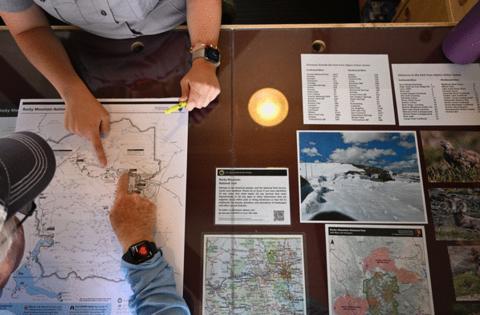Signs posted at National Park Service sites seen as threats to 'whitewash' dark side of Colorado history
Published in News & Features
Rick Williams, the leader of an American Indian group called People of the Sacred Land, reacted with disbelief this month upon learning signs were posted at the Sand Creek Massacre National Historic Site in southeastern Colorado that critics are taking as a threat to whitewash history.
The signs, which were posted June 13 at all National Park Service sites by order of Interior Secretary Doug Bergum, begin innocuously by asking visitors to download a QR code and answer three survey questions. The first asks them to identify areas that need repair. The second inquires about services that need improvement.
It’s the third survey query that is surprising many and alarming some. It asks visitors to identify “signs or other information that are negative about either past or living Americans or that fail to emphasize the beauty, grandeur, and abundance of landscapes and other natural features.”
Williams, whose organization is comprised of Native leaders, elders, and concerned citizens who want the truth to be known about the forced relocation of Native people in Colorado, was shocked.
“I was a little horrified, but I was scared, too,” said Williams, whose ancestry is Oglala Lakota and Cheyenne. “Basically this gives the average citizen a license to determine what they believe the truth is, and defending it against somebody who has an opposing view could create hostility.”
The signs also upset Japanese Americans after they went up at the Amache National Historic Site. Like Sand Creek, Amache is located in southeastern Colorado near the Kansas state line. It was the site of a Japanese internment camp during World War II.
“The way they are written seems to be more applicable to some of the bigger national parks that talk about natural beauty,” said Kirsten Leong, a fourth-generation Japanese American who is vice president of the non-profit Amache Alliance. “That’s not the congressional purpose of places like Amache. In law, the purpose for the park, in the enabling legislation as designated by Congress, is about telling these hard historical stories.”
Amache was one of 10 Japanese internment camps during World War II that were established by the War Relocation Authority. More than 10,000 people, mostly U.S. citizens, were incarcerated there from 1942 to 1945.
At Sand Creek, U.S. troops killed 230 Cheyenne and Arapaho people in 1864, mostly women, children and elderly.
Bergum’s order, issued May 20, implemented provisions of an executive order signed two months earlier by President Trump titled “Restoring Truth and Sanity to American History.” Trump complained about efforts to “rewrite” history by “replacing objective facts with a distorted narrative driven by ideology rather than truth.” He asserted that the nation’s “unparalleled legacy of advancing liberty, individual rights and human happiness is reconstructed as inherently racist, sexist, oppressive or otherwise irredeemably flawed.”
Bergum’s order directs land management bureaus within the Interior Department, which include the National Park Service and Bureau of Land Management, to identify monuments, memorials, statues and markers that “contain images, descriptions, depictions, messages, narratives or other (content) that inappropriately disparages Americans past or living … (or) emphasizes matters unrelated to the beauty, abundance or grandeur of said natural feature.”
Kyle Patterson, public affairs officer at Rocky Mountain National Park, said signs have been posted “in a variety of public-facing locations including visitor centers, toilet facilities, trailheads and other visitor contact points that are easily accessible and don’t impede the flow of traffic.”
Sierra Willoughby, public information officer at Great Sand Dunes National Park, said the signs were posted at the park’s visitor center.
“This effort reaffirms the NPS mission by emphasizing the importance of accuracy in how we tell stories of American history,” Willoughby wrote in an email. ”Our visitors come to national parks to celebrate the beauty, abundance, and grandeur of America’s landscapes and extraordinary multicultural heritage. This allows them to personally connect with these special places, free of any partisan ideology.”
Many park visitors have been using the surveys to plead for increased funding. Advocates for the national parks say they were severely underfunded even before Trump took office. The park service estimates its nationwide backlog of deferred maintenance stood at nearly $23 billion, including $233 million at Rocky Mountain National Park. Now, according to the National Parks Conservation Association, the National Park Service is facing $900 million in budget cuts as part of Trump’s 2026 budget.
“This is the most extreme, unrealistic and destructive National Park Service budget a president has ever proposed in the agency’s 109-year history,” according to a statement issued by National Parks Conservation Association chief executive Theresa Pierno. “It’s nothing less than an all-out assault on America’s national parks.”
Estee Rivera Murdock, executive director of the non-profit Rocky Mountain Conservancy based in Estes Park, said she’s heard that visitors are complaining about inadequate funding in their survey responses.
“I have talked to NPS folks nationwide who are seeing comments come in from different sites and, loud and clear, the dominant theme is ‘We love these places, they need more funding, they need more rangers,’” Murdock said. “It’s hard to solicit feedback from folks to make changes if you don’t have any mechanism or budgets to make those changes.”
With the threat of budget cuts, there are concerns that historic sites like Amache and Sand Creek, with far less visitation than the big national parks, could be closed. Rocky Mountain National Park attracts 4 million visitors annually. Great Sand Dunes and Mesa Verde attracted 437,000 and 480,000, respectively, in 2024. By contrast, Amache had only 4,771, Sand Creek 6,400. Another National Historic Site in southeastern Colorado, Bent’s Old Fort, attracted 16,000.
“We believe in evidence-based history, which I think the parks are currently doing,” said Dawn DiPrince, chief executive of History Colorado, who also serves as Colorado’s official state historic preservation officer. “I don’t think we should be changing that. I am even more concerned about the proposed funding cuts. I’m especially concerned about our three historic sites in southeastern Colorado.
“We have parks that were not created just for visitation numbers,” DiPrince added. “They were created by a whole group of people, collectively, to tell really important American history. That is why they exist, and to measure them by sheer visitation numbers and threaten their existence by budgetary cuts, and suggest we should be amending how we tell those stories in ways that are not evidence-based, feels very problematic.”
Williams said he doesn’t worry much about the Sand Creek Massacre site closing because the land will remain sacred to Native Americans. Victims of the massacre were buried there, Williams said, and their spirits remain.
“Of those 6,400 visitors, probably 6,000 were American Indians,” Williams said, “and they’re going to go there whether it’s a national park or not.”
_____
©2025 MediaNews Group, Inc. Visit at denverpost.com. Distributed by Tribune Content Agency, LLC.







Comments